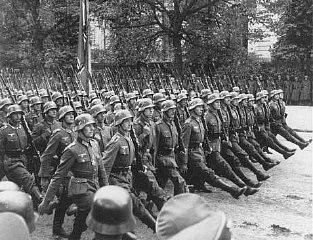
WWII War Begins
Timeline of WWII
1940
Dunkirk Evacuation
The British decided to evacuate their expeditionary force from the harbor at Dunkirk, though they initially expected only about 45,000 troops could be saved.
Hitler and German high command unintentionally gave allies more time at Dunkirk to evacuate by demanding Germany's armored units to pause their advance.
1940

invasion of Poland
German troops were sent to Poland and that made World War II.
Britain and France declared war on Germany, one of Hitlers first major foreign policies after coming to power was to sign a non-aggression pact with Poland.Even tho there was a a non-aggression pact Germany invaded Poland anyways.
1940
Evacuation at Dunkirk
The British decided to leave their expeditionary force fro the harbor at Dunkirk.They thought that an estimate of 45,000 troops could be saved.
Hitler and the German high command unintentionally gave the allies more time to leave by demanding that Germany's armored units stop their advance.
1940
Battle of Britain
There were thousands of bombing runs.
Some 23,000 British civilians were killed between July and December 1940.
Thousands of pilots and air crew engaged in battle skies above Britain, Germany and the English channels.
1941
Attack at Pearl Harbor
To a certain extent the conflict between United States and Japan stemmed from their competing interests in Chinese markets and Asian natural resources.
The ineffectual Stimson Doctrine guided United States policy for Asia for the next decade.
1942
Battle of Coral Sea
by the end of April 1942 the Japanese were ready to seize control of the coral sea,by establishing air bases at port Moresby in southern new guinea and at tulagi in the southern Solomon.
1942

Battle at Stalingrad
successful soviet defense and the city of Stalingrad during world war II. Russians consider this battle the best battle the have been in of all time .
it stopped the German advance to the soviet union and marked the turning of the tide of war in favor of the allies.
1944
D-Day Invasion
Normandy invasion also called operation overlord or d-day during world war II, the allied invasion of western Europe
1945
V-E day
After years of combat stretching from the Atlantic ocean to the middle east rumors began to spread in spring 1945 that the German army was close to surrendering.
over the next 6 months the allied forces squeezed the German army along two fronts back to its prewar boarders then by spring the end of the war felt close at hand.
1945
atomic bomb at Hiroshima and Nagasaki
The explosion immediately killed an estimated 80,000 people; tens of thousands more would later die of radiation exposure. Three days later, a second B-29 dropped another A-bomb on Nagasaki, killing an estimated 40,000 people.
Similar Timelines to Explore
Expolore similar timelines on Timepath and dive deeper into the subject of WWII War Begins. Your journey through connected events and stories starts here. Missed something? We would love to hear your suggestions for additional timelines.